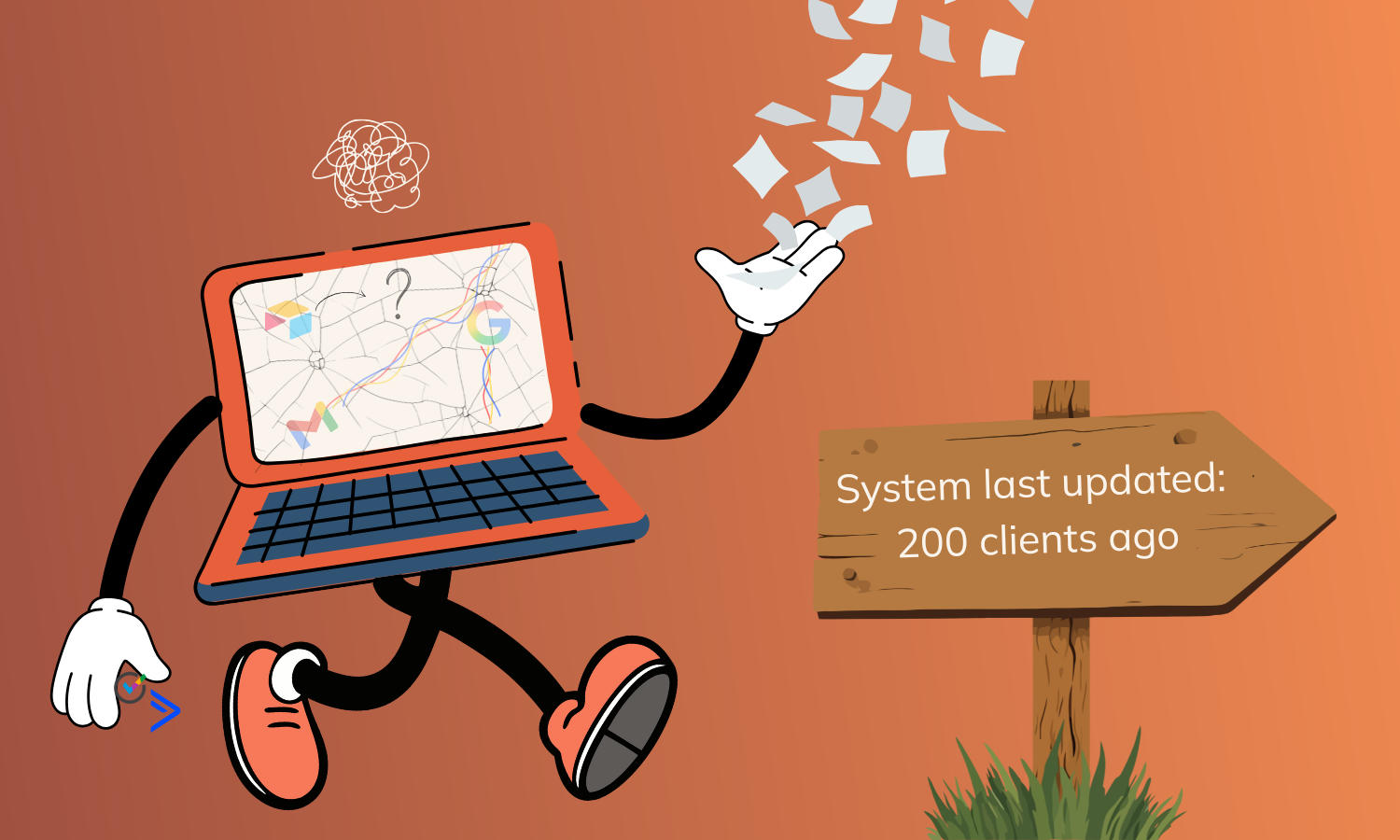
Choosing the wrong business automation tools can cost thousands of dollars and months of frustration. This comprehensive guide provides a systematic approach to software selection that ensures your tools serve your business, not the other way around.
The $10,000 mistake pattern
A business owner I worked with recently invested $10,000 in an all-in-one platform that promised to solve all her operational challenges. After weeks of setup attempts, we evaluated the system and recommended scrapping it entirely. She was working harder with the tool than without it.
This scenario happens more frequently than most business owners realize. The problem isn't necessarily the software - it's selecting tools that don't match how you actually work or what you genuinely need.
How most tool selection fails
The typical software selection process follows this broken pattern:
- Frustration trigger: Current manual processes become overwhelming
- Research overload: Reading "top 10" lists and feature comparisons
- Feature-based decisions: Choosing tools with the most capabilities
- Implementation reality: Discovering the tool doesn't match actual workflows
- Forced adaptation: Trying to change business processes to fit the software
- Abandonment or suffering: Either losing the investment or working within an inefficient system
This approach fails because it prioritizes tool capabilities over business fit.
The 3 P's framework for smart tool selection
Before evaluating any software options, answer these foundational questions that determine whether a tool will actually improve your operations.
Purpose: define your specific outcome
Vague goals lead to poor tool choices. "Better organization" or "increased efficiency" aren't specific enough to evaluate software against.
Instead, define precise outcomes:
- "Automatically generate client proposals from intake form responses"
- "Send follow-up email sequences based on prospect engagement"
- "Create project tasks and timelines from standardized templates"
- "Track time spent on different client activities for accurate billing"
Questions to clarify purpose:
- What specific problem are you solving?
- How will you measure success?
- What does the ideal outcome look like?
- Who benefits from this improvement?
Process: map your actual workflow
Understanding your current process before evaluating tools prevents the expensive mistake of automating broken workflows.
Document your process completely:
- What triggers the start of this workflow?
- What are the exact steps you take currently?
- Where do you make decisions that affect subsequent steps?
- What information do you need at each stage?
- How do you know when the process is complete?
Include the details others miss:
- Time spent switching between tools
- Information that gets lost or recreated
- Steps that get skipped under pressure
- Variations for different types of clients or projects
Example: proposal creation process mapping
A consulting firm thought they needed proposal software, but process mapping revealed the real issue:
- Current belief: "We need better proposal templates"
- Process reality: 60% of time was spent gathering client information scattered across emails, notes, and previous conversations
- Actual solution needed: Client information collection and organization system
- Tool selected: CRM with intake forms instead of proposal software
People: consider who will actually use this
The best tool on paper becomes useless if your team won't use it consistently. Factor in the human element before making technical decisions.
User considerations:
- Technical comfort level of daily users
- Preferred working styles and habits
- Current tool familiarity
- Resistance to change patterns
- Time available for learning new systems
Team dynamics:
- Will remote workers have different needs than office staff?
- Do different roles need different levels of access?
- How will you handle training and adoption?
- What happens if key users resist the new system?
Real example: A design agency selected a project management tool with excellent features but poor mobile access. Since their team frequently worked on-site with clients, the tool went unused and projects returned to email management.
Critical features to evaluate systematically
Once you've clarified purpose, process, and people, evaluate tools against these essential criteria.
User experience as the foundation
If logging into the software feels like a chore, consistent usage won't happen regardless of capabilities.
User experience indicators:
- Can you accomplish basic tasks within 15 minutes of signing up?
- Is the interface intuitive or does everything require explanation?
- Do common actions take multiple clicks or complex navigation?
- Does the mobile experience match desktop functionality when needed?
Warning signs:
- Extensive training required for basic functions
- Cluttered interfaces with overwhelming options
- Slow loading times or frequent technical issues
- Poor search functionality for finding information
Integration capabilities matter more than features
Most businesses use multiple tools. Software that doesn't communicate with your existing systems creates more work, not less.
Integration assessment:
- Does it connect with your current essential tools?
- Are integrations native (built-in) or through third-party services?
- What data can flow between systems automatically?
- How reliable are the integrations during high-usage periods?
Common integration needs:
- CRM to email marketing platform
- Project management to time tracking
- Accounting software to invoicing tools
- Calendar systems to scheduling platforms
Scalability planning
Consider not just your current needs, but where your business will be in 2-3 years.
Scalability factors:
- User limits: How much does additional team member access cost?
- Data storage: Are there limits on records, files, or usage?
- Feature restrictions: Do you lose capabilities if you downgrade plans?
- Export options: Can you get your data out if you need to switch?
Growth scenario planning:
- What happens when you double your client base?
- How will costs change as team size increases?
- Will the tool still work if you add new service offerings?
- Does the vendor have a track record of supporting growing businesses?
Customization vs. complexity balance
More customizable isn't always better. Complex systems often become maintenance burdens.
Customization evaluation:
- What can you modify without technical expertise?
- Do customizations break during software updates?
- How much ongoing maintenance do custom setups require?
- Can you achieve your goals with standard configurations?
Cost of customization:
- Setup time investment
- Ongoing maintenance requirements
- Training complexity for team members
- Vendor dependency for modifications
Industry-specific considerations
Different business types have unique requirements that affect tool selection significantly.
Service-based businesses
Priority features:
- Client communication and project updates
- Time tracking and billing integration
- Proposal and contract management
- File sharing and collaboration tools
Common tools that work well:
- Airtable for client relationship management
- OnceHub for sophisticated scheduling needs
- ActiveCampaign for client communication sequences
Creative businesses
Priority features:
- File version control and approval workflows
- Visual project management interfaces
- Client feedback and revision management
- Portfolio and asset organization
Special considerations:
- Large file handling capabilities
- Color accuracy for design reviews
- Integration with creative software tools
Compliance-sensitive industries
Healthcare, finance, legal requirements:
- HIPAA, SOX, or other regulatory compliance
- Data encryption and security certifications
- Audit trail capabilities
- Access control and permission management
Compliance cost factors:
- Compliance features often require premium plans
- Additional security certifications increase costs
- Training requirements for compliance features
- Regular compliance audits and documentation
The smart tool selection process
Phase 1: requirements gathering (week 1)
Document your 3 P's:
- Write specific purpose statements
- Map current processes completely
- Assess team capabilities and preferences
Create your evaluation criteria:
- Must-have vs. nice-to-have features
- Budget constraints (including hidden costs)
- Integration requirements
- Success metrics
Phase 2: initial screening (week 2)
Research and eliminate:
- Identify 8-10 potential tools
- Check basic requirements fit
- Eliminate obvious mismatches
- Read user reviews from similar businesses
Create a shortlist of 3-4 tools that meet your fundamental requirements.
Phase 3: hands-on evaluation (weeks 3-4)
Test with real scenarios:
- Sign up for free trials or demos
- Test with your actual data and workflows
- Involve team members who will use the tool daily
- Document what works well and what causes problems
Evaluation framework:
- Can you complete your most common task end-to-end?
- How long does basic setup take?
- What breaks or confuses you during testing?
- How responsive is customer support when issues arise?
Phase 4: implementation planning (week 5)
Before final decision:
- Calculate total cost of ownership (including setup time)
- Plan data migration and team training
- Identify rollback options if the tool doesn't work
- Set success metrics and review timeline
Red flags that indicate wrong tool choices
"All-in-one" promises
Tools claiming to handle everything usually excel at nothing. Specialized tools that integrate well often outperform single platforms trying to do everything.
Warning signs:
- Marketing emphasizes quantity of features over quality
- No clear specialty or main use case
- User reviews mention "jack of all trades, master of none"
- Feature list longer than your actual needs
Extreme complexity or oversimplification
Both ends of the spectrum create problems.
Overly complex tools:
- Require extensive training for basic functions
- Need dedicated administrators to manage
- Have steep learning curves that discourage usage
- Offer far more features than you'll ever need
Oversimplified tools:
- Can't handle your actual business complexity
- Lack integration capabilities
- Don't scale with business growth
- Force you to work around limitations constantly
Poor support and documentation
When automation breaks, you need help immediately.
Support red flags:
- No phone support options
- Slow response times (48+ hours)
- Knowledge base with outdated or incomplete information
- User community complaints about support quality
The starter tool approach
Begin with tools that solve specific problems exceptionally well, even if they cost slightly more upfront. Quality beats "beginner-friendly" pricing for tools you'll use daily.
Recommended starter stack
For CRM and project management: Airtable
- Free plan handles most small business needs
- Intuitive interface similar to spreadsheets
- Powerful automation capabilities as you grow
- Excellent integration options
For scheduling: OnceHub
- Free plan offers more than most paid alternatives
- Resource management for complex scheduling
- Superior customization options
- Reliable calendar integrations
For email marketing: ActiveCampaign
- Worth the investment for reliable delivery
- Sophisticated automation sequences
- Advanced segmentation capabilities
- Strong CRM integration
For automation: Zapier
- Simpler than alternatives for non-technical users
- Extensive library of pre-built integrations
- Good documentation and support
- Scales from basic to complex workflows
Avoid these common "beginner" tool traps
Free tools with severe limitations:
- Google Forms (limited functionality compared to specialized form builders)
- Basic scheduling tools (Calendly lacks advanced features)
- Generic email platforms (Mailchimp has delivery and automation limitations)
All-in-one platforms that promise everything:
- Usually excel at nothing specifically
- Higher total cost than specialized tool combinations
- Vendor lock-in with limited export options
Making the transition successfully
Parallel system operation
Never switch completely to a new tool immediately. Run both old and new systems for 2-4 weeks to identify problems before they affect clients.
Transition timeline:
- Week 1: Set up new tool with test data
- Week 2: Begin using for new projects while maintaining old system for existing work
- Week 3: Migrate some existing work to new system
- Week 4: Complete transition if everything works smoothly
Team training and adoption
Training strategies:
- Start with power users who can help others
- Focus on daily tasks before advanced features
- Create internal documentation specific to your workflows
- Schedule regular check-ins to address problems
Adoption indicators:
- Team members choosing the new tool over old methods
- Decreased questions about basic functions
- Improved efficiency in target workflows
- Positive feedback about tool experience
Measuring tool success
Quantitative metrics
Time savings:
- Hours saved per week on target processes
- Reduction in time spent switching between tools
- Decreased time searching for information
Quality improvements:
- Fewer errors in automated processes
- Reduced client communication about missing information
- Improved consistency in deliverables
Business impact:
- Increased capacity without additional staff
- Revenue growth from time redirected to sales activities
- Client satisfaction improvements
Qualitative indicators
Team satisfaction:
- Reduced frustration with daily tasks
- Increased willingness to follow processes
- Positive feedback during team meetings
Client experience:
- Faster response times
- More professional communication
- Fewer mistakes or missed details
When to switch tools
Sometimes the tool you chose doesn't work out long-term. Recognize when it's time to make a change:
Switch indicators:
- Spending more time managing the tool than it saves
- Team consistently avoiding or working around the system
- Business growth exceeding tool capabilities
- Vendor support declining or tool development stagnating
Before switching:
- Document what's not working specifically
- Ensure the problem is the tool, not training or setup
- Calculate switching costs vs. continuing with current tool
- Have a clear migration plan for your data
The compound effect of smart tool choices
Selecting the right automation tools creates a foundation for sustained business growth. Each well-chosen tool eliminates bottlenecks and creates capacity for higher-value work.
The key is starting with tools that fit your current reality while providing room for growth. Perfect alignment between your processes, team capabilities, and tool functionality multiplies the impact of every automation effort.
Focus on solving specific problems with specialized tools rather than seeking one platform that does everything. Build your technology stack systematically, ensuring each addition integrates well with existing systems and genuinely improves your operations.
Remember: the best tool is the one your team will actually use consistently to solve real business problems. Start there, prove the value, then expand systematically as your automation confidence and capabilities grow.



.png)



















